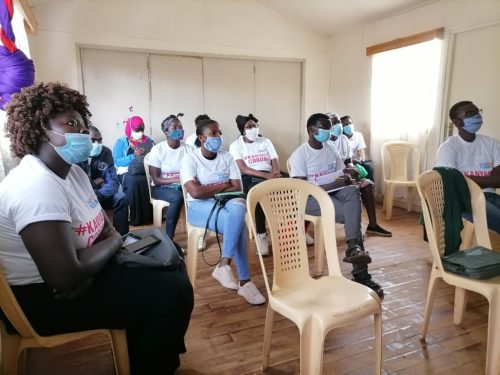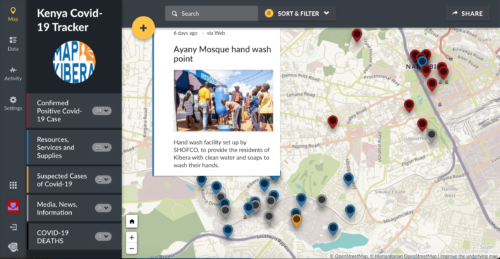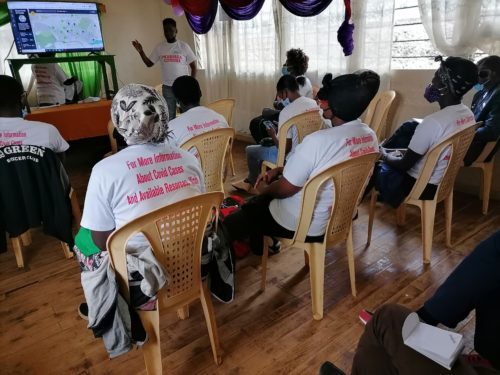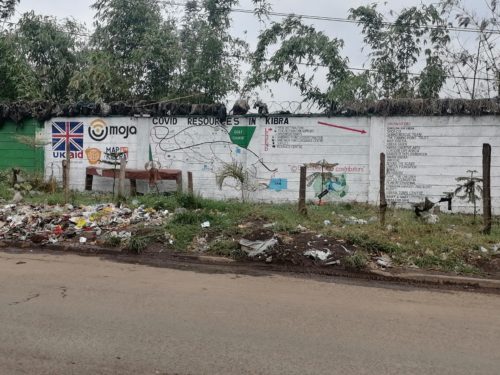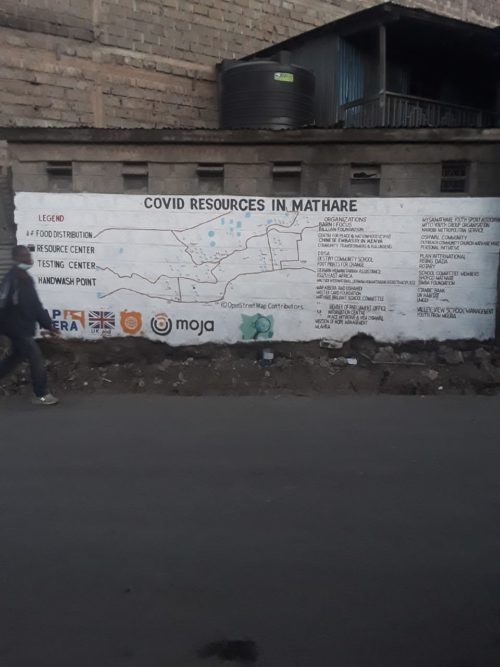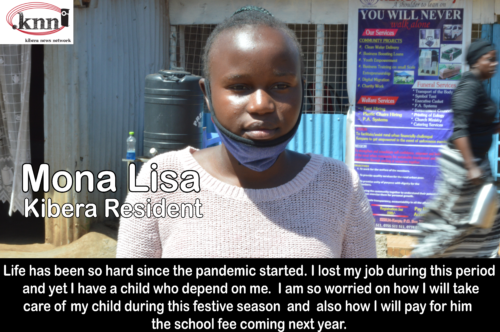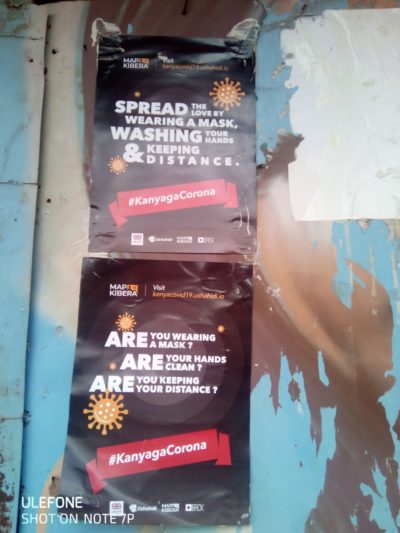One year ago, the world was overwhelmed by the Coronavirus (COVID-19) pandemic. This prompted a change in the way things are done and organizations were forced to adapt new ways of coping with the global crisis. Map Kibera therefore was honored to execute a project dubbed Kenya Covid-19 Tracker that involved mapping of COVID-19 data in Kenya-with emphasis on informal settlements i.e. Kibera and Mathare.Â
Map Kibera designed an open, detailed yet simple Ushahidi Deployment map (Kenya Covid-19 tracker) that illustrates the extent of the infections of the corona virus per county, with help from individual donors through Global Giving. The site has tracked resources made available by many different organizations and the government to halt the pandemic in the slum areas of Kibera and Mathare, such as hand wash points, mask and soap giveaways, food distribution and more. The Kenya COVID-19 Tracker also shows news that is directly related to the corona virus sourced from blogs, websites and eye-witness accounts among other various sources. Visit (https://kenyacovid19.ushahidi.io/views/map)
Though the better half of 2020 involved working remotely as opposed to the traditional 9 to 5, map kibera managed to coordinate a great number of events both remotely and physically with strict adherence to the COVID-19 restrictions that were stipulated by the Ministry of Health and the Kenyan Government. Some of these activities include:
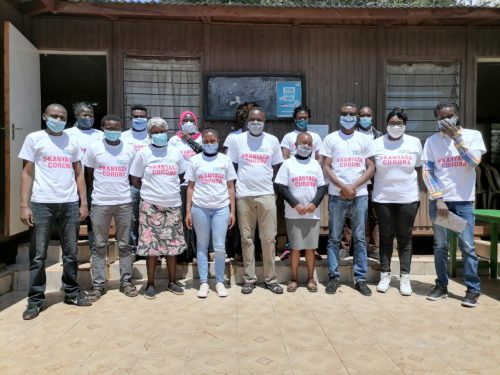
Map Kibera staff together with community volunteers who participated in the project clad in the T-shirts that were distributed to create awareness.
Training of community volunteers.
Thanks to a partnership developed with Ushahidi and FCDO-DAP funding, volunteers and enumerators were trained via webinars and physical meetings that were strictly adherent to the COVID-19 protocols. They used mobile phones to capture data on the ground (Ushahidi Mobile Application) and uploaded the same to the Kenya Covid-19 Tracker. There was also desktop based research that was conducted remotely to report also on the-news, cases of infection, death and recoveries. Additionally, Map Kibera staff were tasked with quality assurance, this ensured that data added on the Kenya Covid-19 Tracker were accurate and timely and as truthful as possible to avoid cases of misinformation and rumor mongering.
Community volunteers from Kibera during one of the training sessions at Mchanganyiko in Kibera.
Field mapping and reporting
Since mapping and data collection is labour intensive, Map Kibera had to recruit data enumerators and volunteers from all the villages of both Kibera and Mathare to assist in the mapping of COVID-19 resources and also report on the news. This involved mapping out of hand washing stations that were donated by various organizations, food distribution conducted by various charitable organizations and also in general; the distribution of various items that ranged from face masks, hand sanitizers and Personal Protective Equipment (PPEs) that were donated to various health facilities to assist in the fight against the spread of COVID-19.
Updates and Follow up
Furthermore, there was also need to make regular updates due to the emerging issues in the wake of the coronavirus pandemic. Towards the end of the year 2020, certain trends were emerging that needed to be captured in the story map. For instance food donations were gradually decreasing as the government initiated economic recovery plans and this move so many people resume work. Consequently as the situation normalized, people also started neglecting some of the protocols and this resulted in the neglect of hand washing stations-which were in most cases taken by individuals for domestic use.
Map Kibera’s Zack Wambua conducting a training session on the Kenya covid-19 tracker project.
 Mural on the Wall
Map Kibera went a step further to draw murals on public spaces in both Kibera and Mathare. The purpose of the murals was to create public awareness and also create an offline platform for the public to interact with the data on the Ushahidi Deployment map (kenya covid-19 tracker). This has proved to be a useful approach because it ensures transparency and data sharing to the benefit of the community at hand-in this case Mathare & Kibera.
Humans of Kibera & Mathare
Kibera News Network (KNN) also started an initiative called Humans of Kibera and Mathare. In this case random people from both locations were interviewed and they shared their ordeal during the Coronavirus pandemic and how they made it through the tough season that was characterized by lockdowns and curfews.
Internet provision from Moja WiFi
Map Kibera also partnered with Moja WiFi to provide internet services at specific public points in both Kibera and Mathare slums. Since most of the work had to be online. Furthermore Moja wifi showed some of the video clips from KNN on their online platform in a bid to further share with the public regarding covid-19 experiences and eye witness stories.
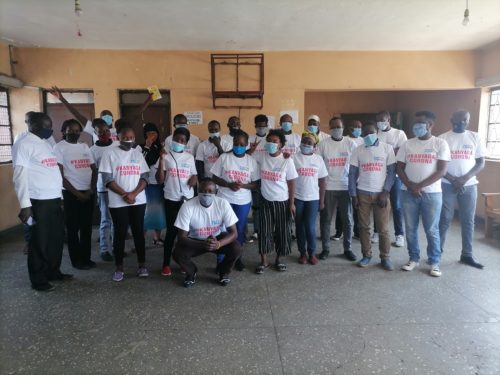 The team from Mathare were equally excited for being involved in the project.
The team from Mathare were equally excited for being involved in the project.
ImpactÂ
The Kenya COVID-19 Tracker had a great impact on the residents of Kibera and Mathare as well. People had the chance to interact with the data through the wall murals and the online platform. “…We know that information is power and the ability to access it is even more powerful…†as stated by Moses Omondi, a resident of Kibera and also team leader for Adopt a family, an NGO that has used the data provided by the Kenya COVID-19 Tracker deployment map. He further acknowledged that the map offered direction in terms of where to source for different services, how to also access different resources like food distribution and donations with regards to the COVID-19 challenges in Kibera. The deployment map was created in a way that it can be used for various purposes like for health reasons, logistical and also general information.Â
In conclusion, the Kenya Covid-19 Tracker Project was a success and the extensive data that was generated is actually free to all interested parties and can prove resourceful with regards to how informal settlements are equipped in times of distress; for this case a disease outbreak. This open data can be used to address an occurrence of the same nature and magnitude and with the insights provided, the necessary measures can be applied to achieve the best results in governance and service provision.
